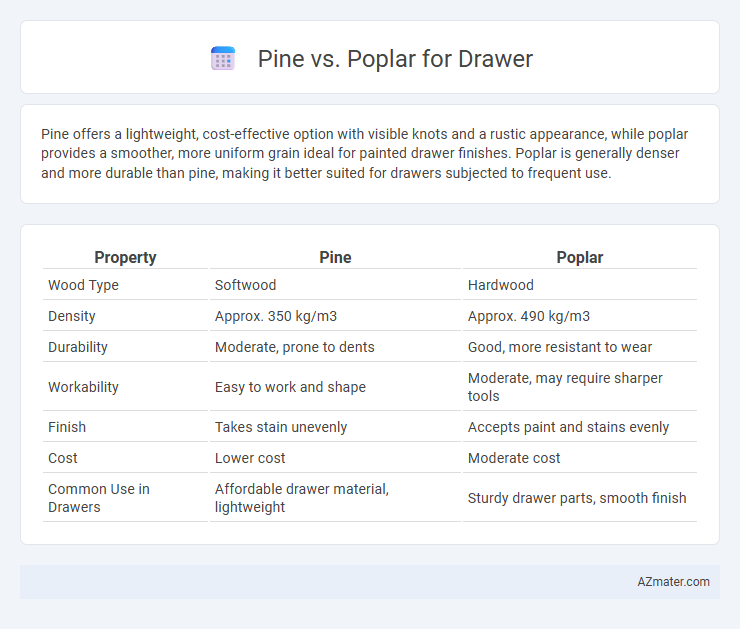Pine offers a lightweight, cost-effective option with visible knots and a rustic appearance, while poplar provides a smoother, more uniform grain ideal for painted drawer finishes. Poplar is generally denser and more durable than pine, making it better suited for drawers subjected to frequent use.
Table of Comparison
| Property | Pine | Poplar |
|---|---|---|
| Wood Type | Softwood | Hardwood |
| Density | Approx. 350 kg/m3 | Approx. 490 kg/m3 |
| Durability | Moderate, prone to dents | Good, more resistant to wear |
| Workability | Easy to work and shape | Moderate, may require sharper tools |
| Finish | Takes stain unevenly | Accepts paint and stains evenly |
| Cost | Lower cost | Moderate cost |
| Common Use in Drawers | Affordable drawer material, lightweight | Sturdy drawer parts, smooth finish |
Introduction: Pine vs Poplar for Drawer Construction
Pine and poplar are popular woods used in drawer construction, each offering unique properties suited to different needs. Pine is a softwood known for its affordability, lightweight nature, and characteristic knots, making it suitable for rustic or traditional furniture styles. Poplar, a hardwood, provides a smoother finish, superior durability, and ease of painting, making it ideal for furniture requiring a clean, modern look and longevity.
Material Overview: Pine Characteristics
Pine wood for drawers offers a lightweight and affordable option with a straight grain and pale yellow hue that enhances natural aesthetics. Its moderate softness allows for easy machining and carving but may be prone to dents and scratches over time. Pine's natural resin content provides some resistance to decay, making it suitable for indoor furniture where durability and cost-effectiveness are key considerations.
Material Overview: Poplar Characteristics
Poplar wood is a lightweight hardwood known for its fine, even texture and straight grain, making it a popular choice for drawers due to its smooth finish and ease of painting or staining. It offers moderate strength and stability, with good resistance to warping and shrinking, which helps maintain drawer shape and function over time. Unlike pine, poplar has fewer knots and a more consistent pale color, which provides a uniform surface ideal for customized finishes.
Appearance and Grain Differences
Pine wood displays a light yellow hue with prominent knots and a distinct, straight grain pattern, offering a rustic and natural appearance ideal for casual or country-style drawers. Poplar features a more uniform, pale cream to light green color with a fine, straight grain that is smoother and less knotty, providing a cleaner and more contemporary look. The grain differences between Pine's more pronounced texture and Poplar's subtle, consistent pattern help determine the drawer's aesthetic suitability for various interior styles.
Strength and Durability Comparison
Pine wood offers moderate strength and durability, making it suitable for lightweight drawer construction but prone to dents and scratches over time. Poplar wood exhibits higher strength and better resistance to wear, ensuring longer-lasting drawers with greater structural integrity. Choosing poplar results in drawers that withstand daily use more effectively compared to pine.
Workability and Ease of Machining
Pine offers excellent workability due to its softness, making it easy to cut, shape, and sand, which is ideal for drawer construction. Poplar is slightly harder but machines smoothly with minimal tear-out, providing clean, precise edges and a smooth finish for detailed drawer components. Both woods respond well to nails and screws, though pine may require pre-drilling to prevent splitting due to its grain structure.
Cost Differences: Pine vs Poplar
Pine is generally more affordable than poplar, making it a cost-effective option for drawer construction. Poplar tends to be pricier due to its durability and smoother finish, which are often preferred for higher-end furniture. Choosing pine can reduce material costs significantly while still providing adequate strength for most drawer applications.
Finish and Stain Compatibility
Pine offers excellent stain compatibility due to its open grain, absorbing finishes evenly and allowing for rich, warm hues in drawer construction. Poplar's tighter, closed grain presents a smoother surface ideal for paint finishes but can require pre-treatment for uniform stain application. Both woods respond well to common drawer finishes like polyurethane and lacquer, yet pine's texture highlights natural grain patterns while poplar provides a cleaner, more uniform look.
Best Applications for Each Wood Type
Pine is ideal for drawers in rustic and country-style furniture due to its lightweight nature and ease of staining, offering a warm, natural appearance. Poplar is best suited for painted drawers or intricate woodworking projects because of its smooth grain and resistance to warping, providing a stable and durable surface. For heavy-use drawers requiring strength and longevity, poplar outperforms pine by maintaining better structural integrity over time.
Conclusion: Choosing Between Pine and Poplar for Drawers
Pine offers affordability and a rustic look with its softwood characteristics, making it ideal for budget-friendly drawer projects that emphasize natural grain patterns. Poplar provides a smoother, more uniform finish and greater durability due to its hardwood status, making it preferable for painted drawers and long-term use. Selecting between pine and poplar depends on budget, desired finish, and durability requirements, with poplar being better for strength and paint, while pine suits cost-effective, natural wood aesthetics.

Infographic: Pine vs Poplar for Drawer
 azmater.com
azmater.com